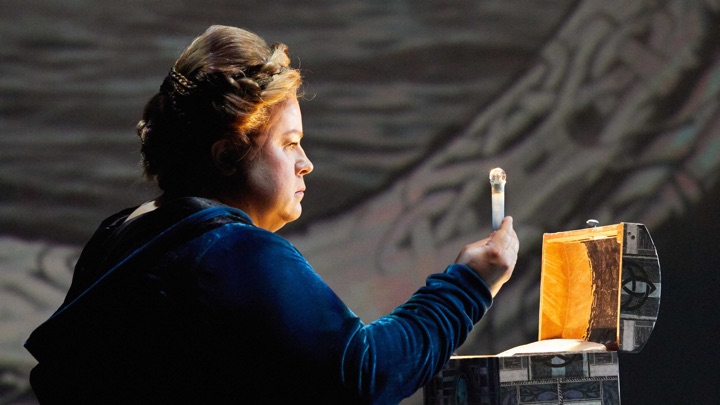

First, this international collaboration between Christina Scheppelman and Argentine director Marcelo Lombardero not only presents the house’s fourth exploration of this paean to romantic love, it is also the first Wagnerian opera mounted by the company since the COVID-19 pandemic, and is arguably its most ambitious staging of these sprawling works since its celebrated 2013 Ring Cycle.
Most notably, it represents a return to form for a house that casts an indelible imprint on the history of Wagner performance in North America.
Wagner’s Tristan und Isolde received its first production in Seattle in 1981, in a homegrown staging created by local musical luminaries Henry Holt and Lincoln Clark while starring Johanna Meier and Edward Sooter as the ill-fated lovers.
The company wouldn’t revisit the work until almost two decades later, this time under Speight Jenkins’ and Francesca Zambello’s vision that memorably united Ben Heppner and Jane Eaglen in their role debuts. The third in 2010—a Peter Kazaras creation that met halfway between traditional photorealism and coloristic abstractions—marked the final Tristan from the company’s artistically rich Speight Jenkins era.
In Seattle’s latest realization of Tristan, Lombardero and his creative team plant the singers in a bare space augmented with front-and-back virtual reality projections. Apart from essential props required for advancing the plot, the greater part of the narrative’s physical elements are depicted using richly illustrated, Tolkien-esque cartoons (inspired by the South American artists Alberto Breccia and Hugo Pratt) intermixed with realistic video projections of nature, the ocean and space.
Although the stage aesthetic and Luciana Gutman’s opulent costumes are conventional, the set’s minimalism theoretically provides a framework for seasoned interpreters to focus on the libretto’s psychological nuances.
This concept’s execution in practice is another matter, and Lombardero’s treatment was rendered uneven by the absence of a consistent dramaturgical vision that most noticeably affected the realization of Isolde’s character.
Productions that set static librettos like Tristan amid physical minimalism are not new. For instance, Wieland Wagner’s legendary Neo-Bayreuth production from the 1960s and Bill Viola’s compelling Tristan Project were masterclasses in exacting compelling dramatic interpretations in the sparest of settings.
Lombardero’s appealing projections certainly succeeded in seamlessly shifting between the narrative locales within Tristan’s ship, Cornwall, and Kareol. During the mesmerizing love duet, the transformation of Marke’s castle in Cornwall into an ethereal depiction of space-time beautifully evokes the metaphysical aspects of Wagner’s text.
Yet, in spite of these lovingly constructed details, Wagner’s Tristan ought to rest on the dramatic acumen of its musical interpreters. On opening night, while the performances from Stefan Vinke’s Tristan and Ryan McKinny’s Kurwenal stand out, the other principals’ interpretations at times lacked the former artists’ specificity in their characters’ musical preparation.
Ultimately, this production’s imbalances appeared to stem from an experience tailored more towards enhancing the visuals rather than unifying the vocalists towards an exacting interpretive vision.
These issues manifested most clearly in the Isolde-centered scenes of Act 1, where the princess’s complex and wide-ranging dramatic palette were undermined by Mary Elizabeth Williams’ disjointed vocal registers and her unfamiliarity with Wagner’s idiom.
Another crucial moment that diminished the narrative’s impact came after the lovers imbibed the potion—specifically in that turbulent orchestral interlude between Isolde’s “Verräter! Ich trink’ sie dir!” and the lovers’ first tender utterances of each other’s names. Rather than conveying the score’s undercurrent of dangerous, unbridled passion, a tepid recognition scene failed to build up towards the devastating climax that closed the first act.
Gratefully, the performance’s arc improved in the latter parts—made so by Tristan’s greater presence in the narrative. Much as in his winning portrayal of Siegfried, Stefan Vinke brings to Tristan an indefatigable heldentenor of sturdy, muscular brilliance and a physical intensity that allowed him to fearlessly traverse this complex character’s broad emotional compass.
While his midrange could sound occluded during introspective moments, his voice opened up and excelled as the line rose higher, inhabiting his impassioned and delirious lines in Acts 2 and 3 with a fullness and abandon that eludes most artists in this repertory. Indeed, Vinke’s musical gifts transformed the opera’s third act into its musical and dramatic apex, here portrayed as something akin to a mad scene for heldentenor.
McKinny accompanied Vinke’s Tristan with a gripping Kurwenal that supplied lyricism and sensitivity while comforting his deteriorating master. Amber Wagner, in her first operatic appearance since her change of management, brought to the part of Brangäne a voice of remarkable amplitude, security, and luster.
Ms. Wagner’s impactful, beautifully sculpted phrases enveloped one in a wall of tone that suggests potential for undertaking the composer’s most challenging heroines. One hopes that this engagement will represent the first of many that will continue to build Ms. Wagner’s musical and dramatic abilities in this repertory.
As Marke, Morris Robinson unfurled a bass of velvety richness, imbuing the character’s anguished scene in Act 2 with beauty and pathos. Lastly, one must commend the Seattle-based tenor Andrew Stenson for his beautifully and lyrically sung sailor and shepherd.
Jordan D’Souza directed the Seattle Symphony in a meticulously shaped, beautifully tinted and propulsive reading of Wagner’s Tristan. For a young conductor’s first take on this cornerstone of operatic history, d’Souza impressively drew myriad details and color from the score and contributed to his accomplished ensemble’s musical success.
Special mention be made of bass clarinetist Eric Jacobs‘ and cor anglais soloist Stefan Farkas’ characterful, excellently played solos. If opening night’s performance couldn’t be regarded as an unqualified success due to the soprano’s uneven Isolde, Vinke’s compelling Tristan, a strong supporting cast, and an exciting conductor and orchestral performance nevertheless contribute to another memorable experience of this magnificent score.
Photos: © Sunny Martini




























Comments